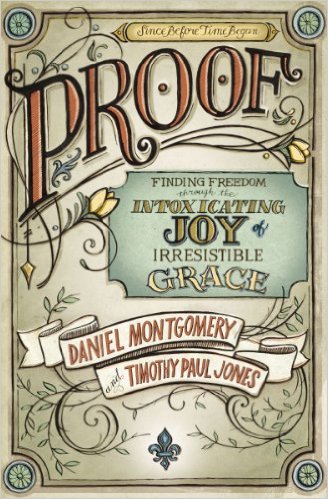Daniel Montgomery and Timothy Paul Jones (both pastors at Sojourn Community Church in Louisville, KY) have written a nice little book that reformulates the 5 major sections of the Synod of Dort’s soteriological formulation (AKA, the 5 points of Calvinism). They write that the purpose of PROOF is to “be an alarm clock that awakens you from the delusion that life depends on you and frees you to discover the intoxicating joy of God’s wild and free grace” (16). Furthermore, they write: “part of our purpose is to point you away from Calvinism–or, perhaps more precisely, to push your focus away from Calvinism as a system and toward the gospel of God’s grace. You may be a Calvinist, an Arminian, neither one, or someone who’s about to Google both terms because you have no clue what we’re talking about– but not matter where you stand or where you land, we long for you to drink deeply from the well of God’s grace and to share this grace with others” (133).
After an opening chapter that explains why we need a grace-centered understanding of salvation, each of the next five chapters is devoted to a letter of PROOF. The acronym is a handy little way to summarize Dortian soteriology:
P = Planned Grace (Limited Atonement, or Particular Redemption)
R = Resurrecting Grace (Total Depravity)
O = Outrageous Grace (Unconditional Election)
O = Overcoming Grace (Irresistable Grace)
F = Forever Grace (Perseverance)
The concluding chapter explains how this system should impact our lives. It also includes a historical look at the Dortian pronouncements, Calvinism, and a discussion of why they prefer PROOF to the traditional TULIP.
Positives
This book was quite a joy to read. It is well written, full of contemporary pop culture references. The prose is [thankfully] not the typical reformed soteriological tome that smells of a dusty old library. Instead, PROOF feels more like something that I could go through with a new believer or disciple.
However, the ease of reading does not mean it is not packed with information. For the academically inclined, like myself, I loved the extensive endnotes found in the back of the book (over 40 pages!). These notes include well researched historical arguments and all the tedious exegetical leg-work. The combination of approachable prose and scholarly support makes this book useful for Christians young and old.
Additionally, I appreciated the charts, excurses, and appendixes. I may just be a product of the USA Today generation, but putting information in graphical form makes it much easier to digest sometimes, e.g.,: the chapter on Overcoming Grace includes a nice little summary chart explaining the ordo salutis in Ephesians (95), and the chapter on Planned Grace has a chart explaining the Christus Victor and Penal elements of the atonement found in the NT (32). There are also several excurses that are worthwhile, for example: for whom did Christ die? (32), foreknowledge (72), inward and outward call (92), and perseverance (118). Finally, the appendixes were also a welcome addition. Five were included, and each is a nice summary: (1) “PROOF Texts” (those Sojourn guys are clever), (2) a summary of their PROOF model, (3) For Whom Did Jesus Die?, (4) a summary of traditional view on Predestination, and (5) a discussion on Freewill. Each of these would be very helpful for those new to the faith, new to the soteriological discussion, or otherwise interested in learning about the most common views.
Negatives
In truth, my only negative comment is actually a question raised by the book. Other than a few editorial misjudgments that have already been repented of, I only have one question: is PROOF any more clear than the original TULIP? That is, does the term Planned Grace take less explanation than Unconditional Election? Or does Outrageous Grace need less elaboration that Limited Atonement (or Particular Redemption)? Indeed, others have even tried their own reformulation of the TULIP (e.g., Timothy George’s ROSES), but the TULIP still reigns. Though I certainly understand the impulse to “contextualize creatively” (172) in order to see the doctrines of grace cherished by the next generation, I am not sure if this new formulation will stick around as successfully as the TULIP has. Time will tell.
I am grateful for any book that focuses sustained attention on God’s gracious work in salvation. I hope that this book gets a wide readership. And, regardless of whatever silly (often flower-related?) acronym sticks, may God get the glory for the things He hath done.




















